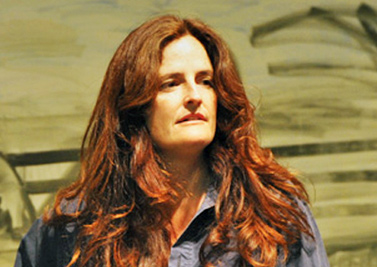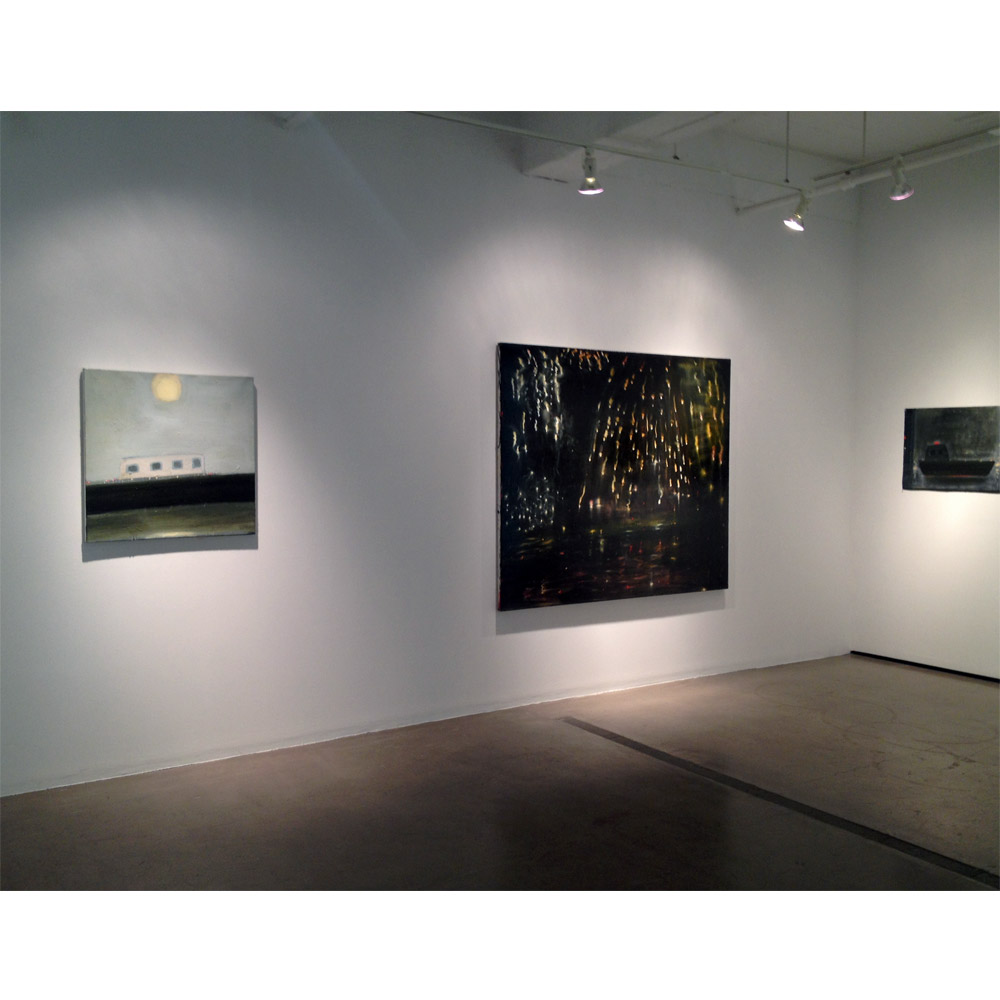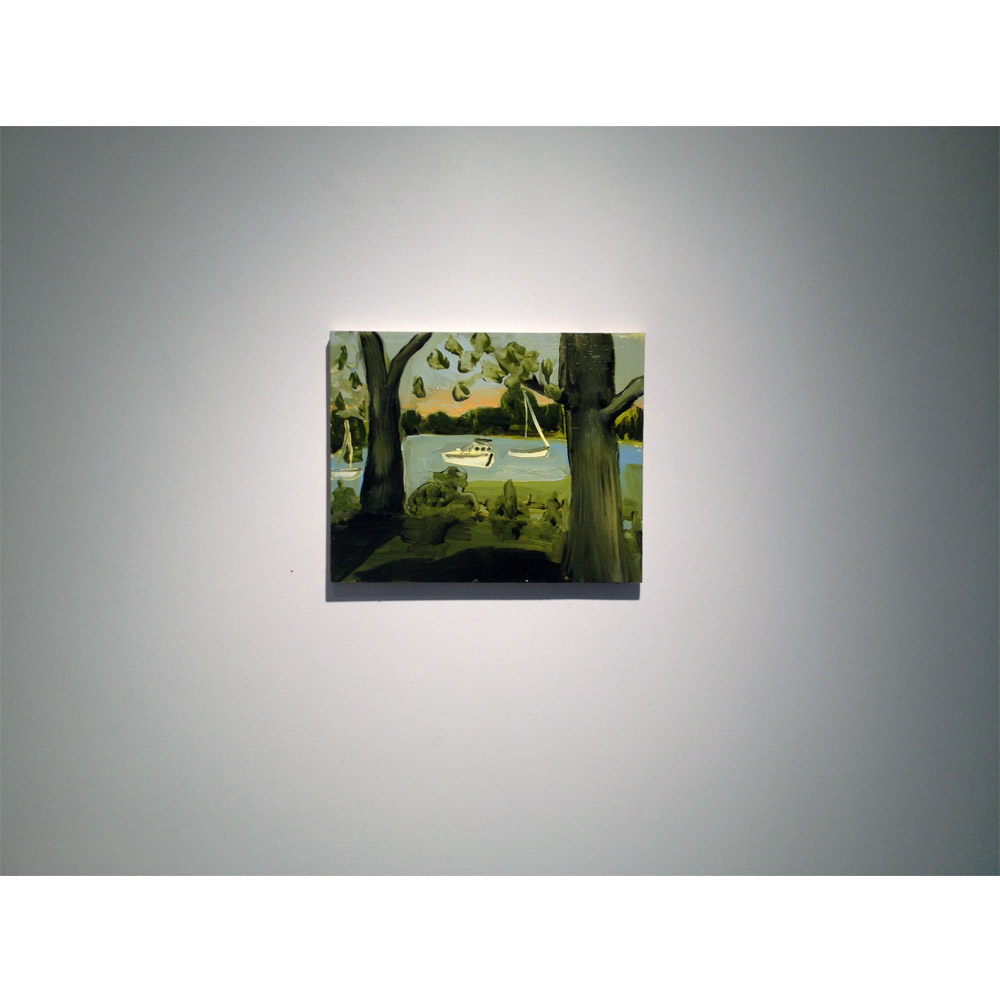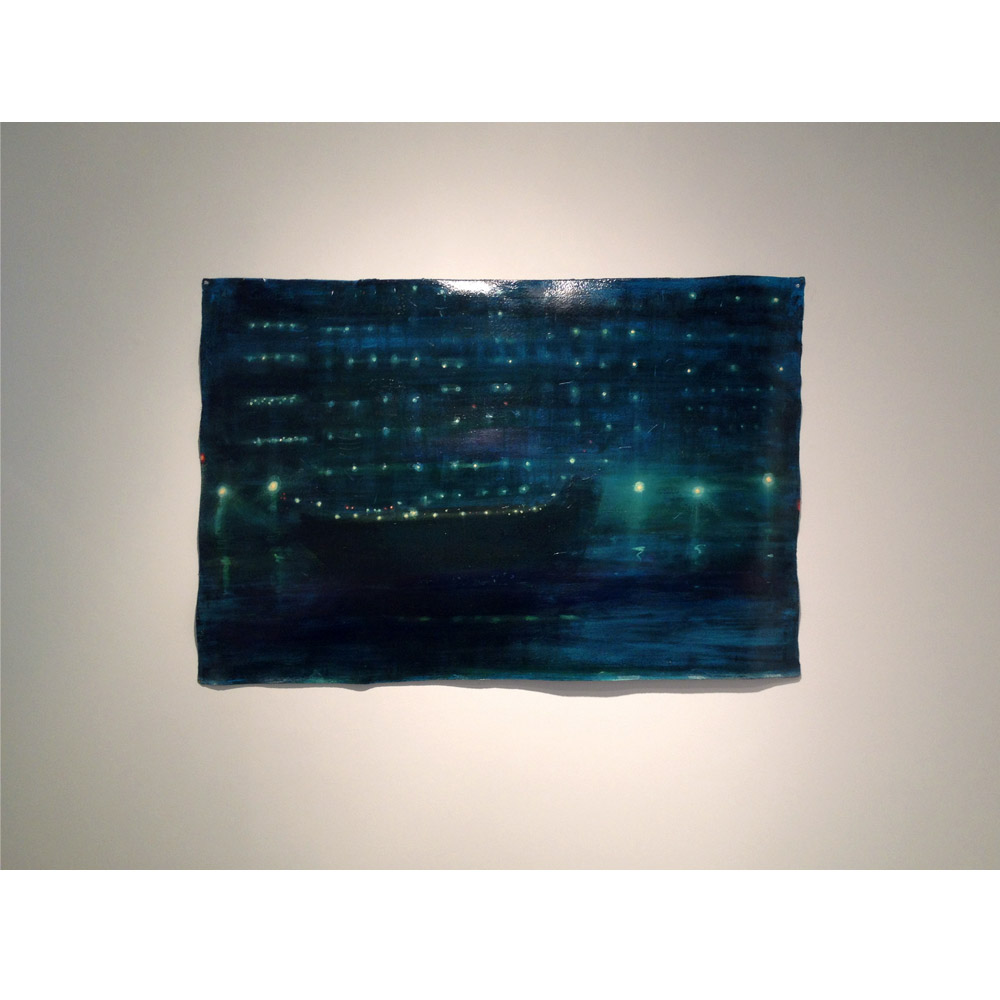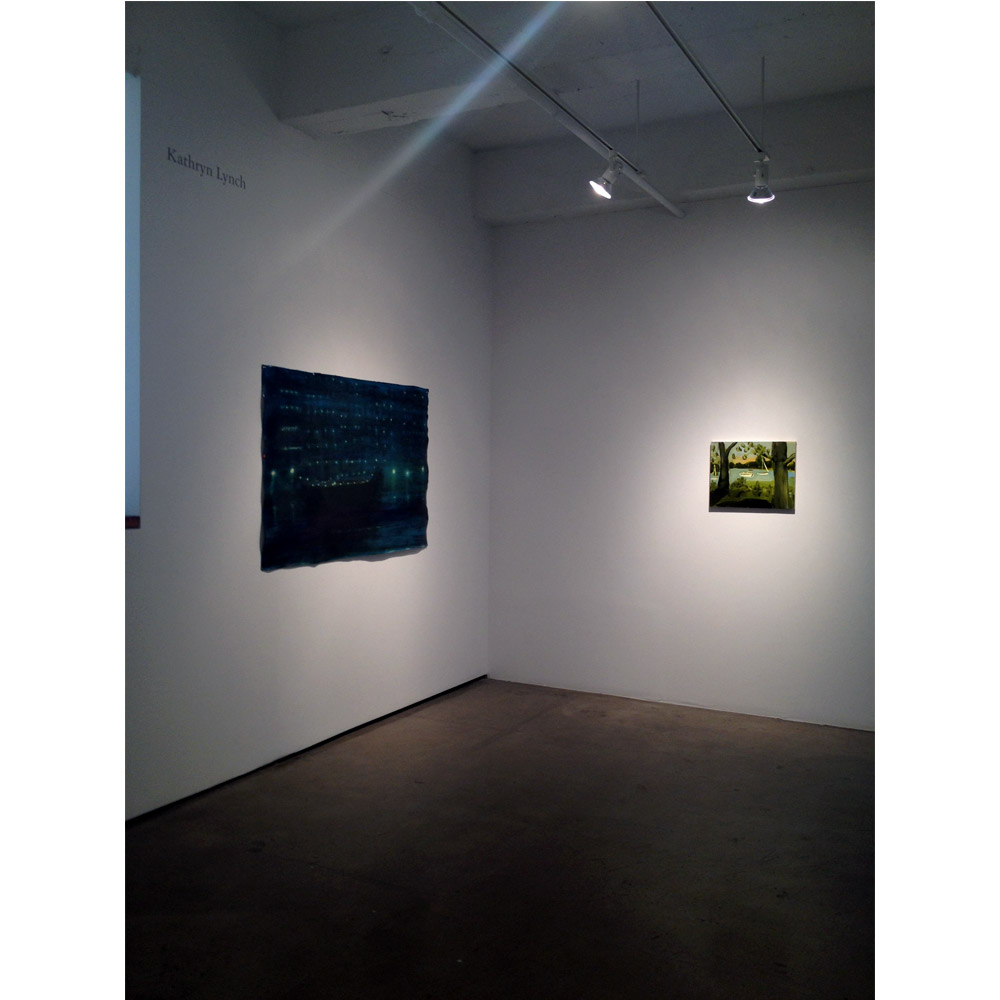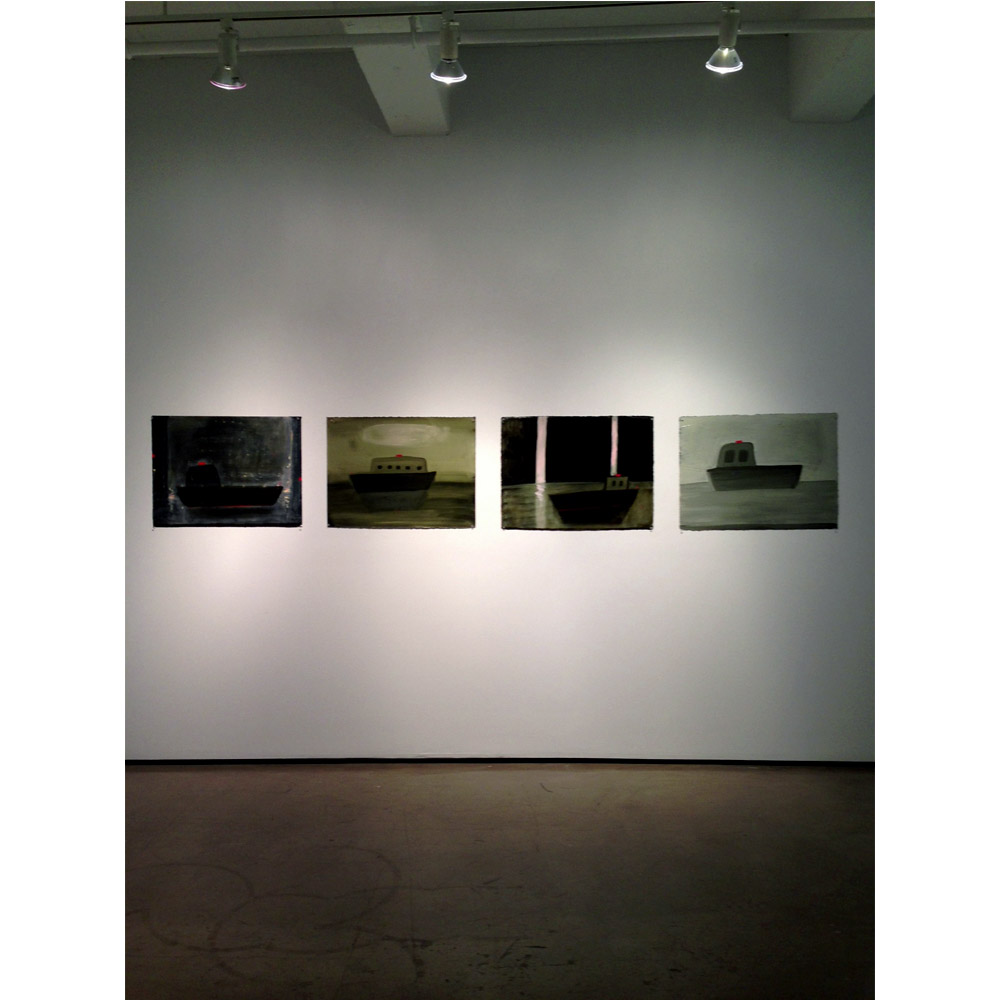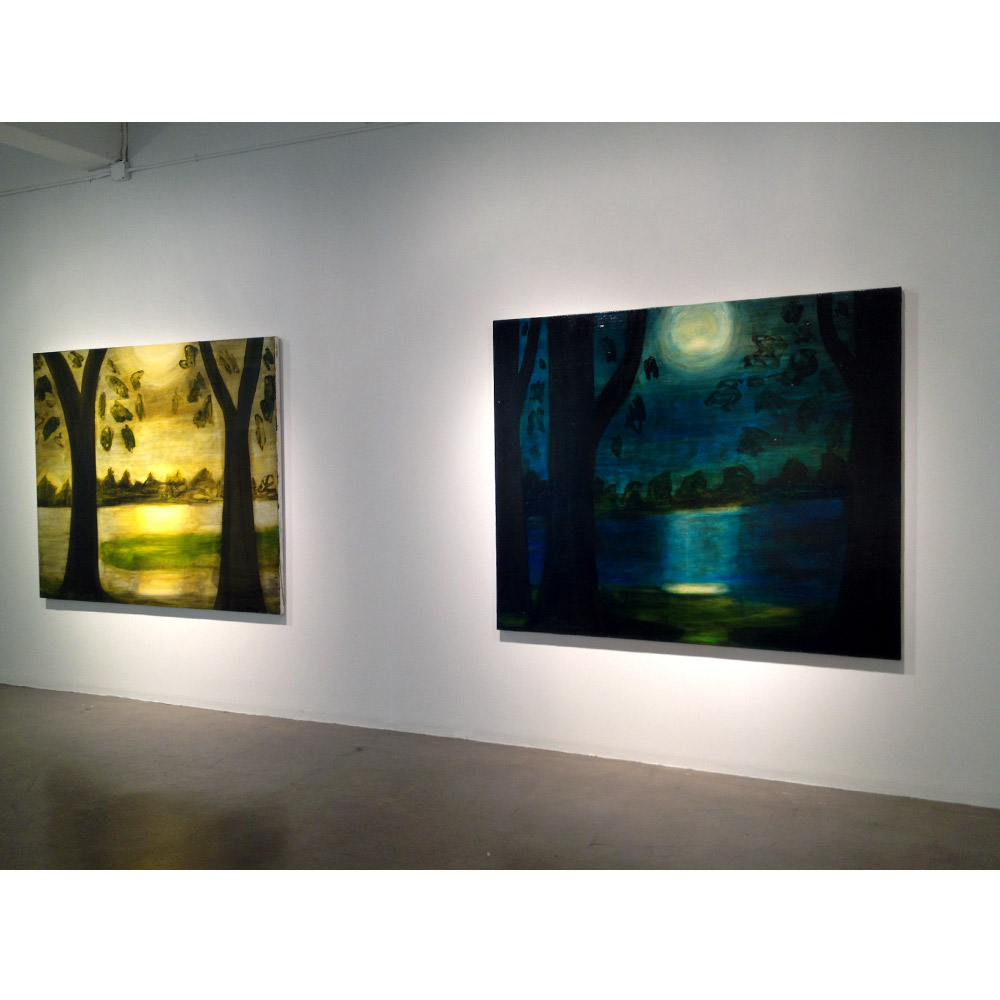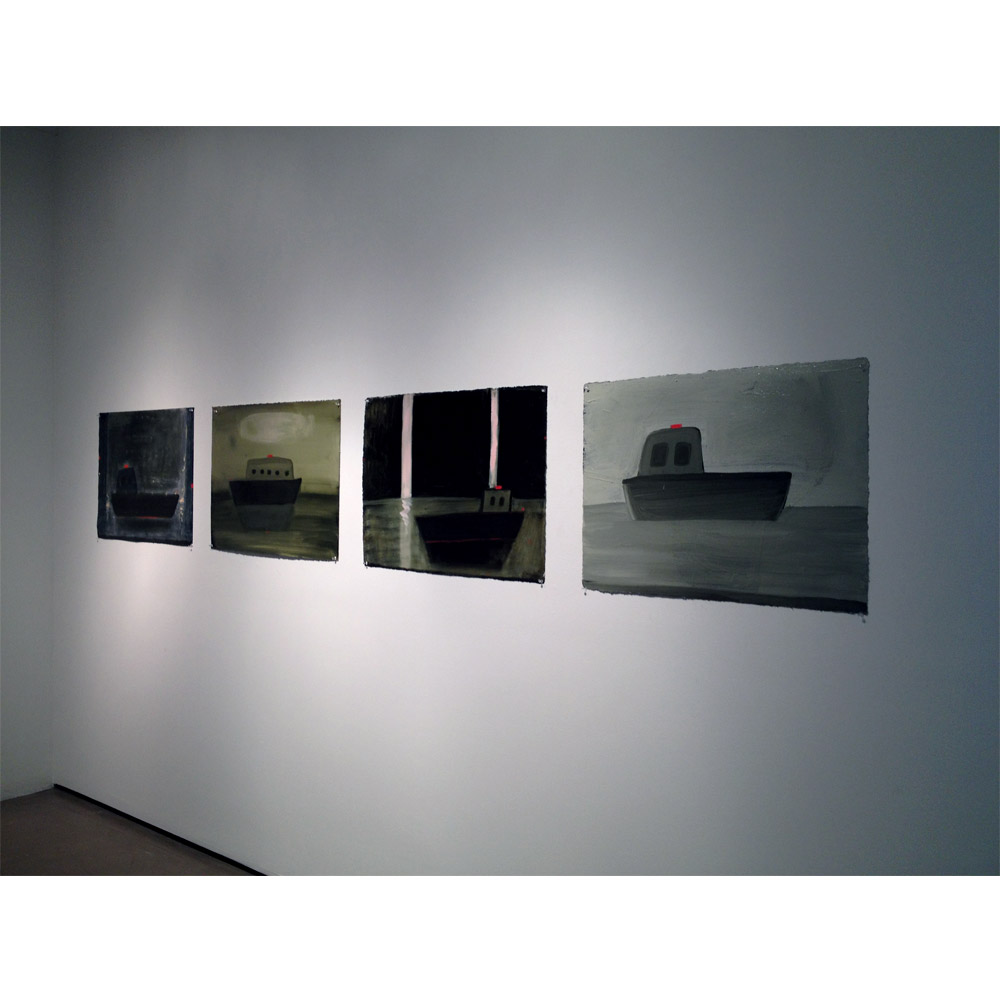Kathryn Lynch walks for two hours a day through the city, mostly just looking at things. “When I’m walking, I’m working,” she says. This initial gathering of visual information serves as the starting point for her paintings. Often her subjects stem from observed places around Manhattan, and sometimes from observed places along the Hudson river, from the café she frequents, or from her second house on Shelter Island. Her style could be labeled “Expressionist,” finding ground somewhere between abstraction and representation, but it’s not easy to categorize. Her painting “Big White Flower” features a white simplified flower shape, with green gestural strokes representing leaves and a stem fading into a dark background. The flower shape looks like no flower that exists—more like an idea or dream of a flower. There’s a dark undercurrent to much of her work, but it has remained popular not only with gallerists, but with celebrity buyers. (Jennifer Lopez and John Slattery are rumored to be among them.)
The painter’s workspace, in a Tribeca garage studio, is tucked behind another artist’s crates, so that one has to walk through a small pathway to arrive there. The area the path opens out onto contains large and small paintings, mostly oil on canvas, propped up along the walls. Some of the paintings are of large graphic-looking flowers, others are of fireworks, still others are of feet, and some are of trees. A large folding table on the left side of the room is covered with cheap bristle paint brushes and oil paint tubes, pie tins of paint medium mixed with pigment and oil paint. Scattered on the floor are several of Lynch’s recent tug boat paintings—others are currently on show at the Senaspace Gallery on Centre street in Manhattan—but these are done on paper.
“Big White Flower” and several of Lynch’s most recent paintings comprise part of “A Silent Language,” the artist’s fifth solo show for the Sears-Peyton Gallery in Manhattan’s Chelsea art district. It runs through December 21, 2013.
I sat in an old armchair speckled with paint at Lynch’s studio as she told me about motherhood, a New York City that’s constantly evolving, and why she feels the recurrent urge to throw “life events” onto canvas.
—Haniya Rae for Guernica
Guernica: New York City and its surrounding areas are a recurring motif in your work. How long have you lived here?
Kathryn Lynch: Since 1983. But I left for graduate school in 1987 and attended the MFA department at the University of Pennsylvania. I returned to New York in 1991.
When I first got to NYC I was terrified to be a painter. I needed to pay my rent, so I was spending a huge amount of time working at jobs I had no interest in. I realized quickly that I wasn’t going to be very good at working for somebody else. My first job was calling for institutional reports at First Boston; I had the absurd notion that I could make a lot of money in banking and then be an artist. Most of the time I pretended to make calls and spent most of my time scribbling on a big sheet of paper I found in the supply room. I lasted six months. Next, I decided I was only cut out for creative endeavors, so I worked for an architect, then a fashion photographer, only to realize I could never escape or ignore my passion to paint. I became friends with a bunch of artists who were all working for Buzzy O’Keeffe, who owned The Waterclub. I worked there until I could begin an MFA program at Penn.
Once you know that you will be poor and miserable working, it is very easy to dedicate yourself to being a poor and happy artist.
Once you know that you will be poor and miserable working, it is very easy to dedicate yourself to being a poor and happy artist. I love a watercolor book by the writer Henry Miller titled Paint as You Like and Die Happy. The lack of a promising career made it easy to take out a crazy amount of student loans and go to graduate school. When you dedicate yourself to painting, it gets easier and easier to paint and all your initial fear just disappears.
Guernica: How has the New York art scene changed since you’ve been here?
Kathryn Lynch: Art has been marketed to the hilt. Prices of art have gotten so high and extreme. People buy art the way they buy stock now, and it’s manipulated like stock. It’s depressing to see art so commodified. At the same time, it is really exciting to see so many people all around the world making art.
I don’t have much to say about the New York art scene, that’s not why I paint. I am interested in the work it takes to make a piece of art, not the world around the art market. There is a video by the artist Isaac Julien called “Playtime” currently playing at Metro Pictures that tells it like it is in regards to the high-end art market.
Guernica: Why keep doing it?
Kathryn Lynch: Making art engages you in a solitary process of exploration—I like to keep changing what I am doing. As a painter, I am often painting something I have little control over. To make art I have to be messy and allow for mistakes and failures. I am not in control of my process—maybe I thrive in chaos. Yes, the art market changes—painting is declared dead and then it is declared alive and well—but I am not interested in what is “new” in that sense. The desire to make art is ancient.
If all the world were populated by people in the arts, there would probably be no war.
What I do like about the current art market is that it is global—more people than ever are artists and I think that’s a good thing. If all the world were populated by people in the arts, there would probably be no war [laughs].
Guernica: How has New York City itself changed since you’ve lived here, and how have those changes affected your painting?
Kathryn Lynch: My paintings are done alone in my studio. The city has become more extreme, as is echoed by the art market. The rich are richer and there is a great disparity between the rich and poor. However, this is not what I am painting. It makes me sad, but my paintings are based on simpler matters. I paint because we die. I don’t think I’m ever painting the place or the thing I’m painting. I’m painting something that isn’t an object-based thing. It’s more about time and the passing of time.
I’ve read about a bunch of painters who say they think a lot about death. I’m the same. I am not a political artist, everything can change around me and I’ll still see death and simple shapes and opposing forces. I am always interested at how contemporary books and paintings can feel even though they were created in another time period. Art is timeless.
I once had a studio at the edge of Greenpoint on Manhattan Ave. A bunch of my friends from graduate school got together and took over an abandoned old building. Together we constructed our own handmade housing and studios. We were all so poor but because everyone was so passionate about what they were doing, we didn’t really suffer. Cheap rent is very important. Artists need affordable studios and housing. That was a really fun time to be in Brooklyn and I feel there was more [of a] possibility of handmade housing and affordable artist space.
I still love New York City. When you have love for a city, you don’t let the changes bother you too much. New York is a walking city. Walking through New York is like walking into infinity—it goes on and on, and although New York changes as you walk its streets, you have that intimate relationship with it, you’re able to pass through it on foot. The best cities are walking cities and they always feel like home and help you think.
Guernica: You say that when you walk, your attention is grabbed by potential subjects to paint. What kinds of things grab you when you walk New York these days?
Kathryn Lynch: Really, it happens so subconsciously. All of a sudden something on my periphery will have this activity to it—a liveliness. Something I see as I pass by slowly gets into my unconscious. It’s kind of like a mutual dialogue and I don’t know what to expect, and I don’t know what the next thing I’ll get interested in will be. Something happens and then I think, “Oh, that’s my subject.”
I get flustered when someone asks me what I paint. The truth is I paint flowers, trees, suns, moons, and dogs, and that just sounds so trite.
These are the subjects I hang the paint on, but I am really painting something there is no word for.
This is why I know I am not painting these things. These are the subjects I hang the paint on, but I am really painting something there is no word for.
I have to give a talk in Los Angeles soon and I decided to name the talk, “Flowers, Trees, Moons, Dogs, and other life events.” Life events: that’s what I’m trying to paint. Something beyond the thing itself. Sometimes something dark, or lonely, that captures a sense of time slipping away.
Guernica: Do your smaller paintings inform the larger ones? Do you paint larger paintings from small sketches?
Kathryn Lynch: Yes, my small paintings can definitely inform the larger ones. But not all the time. Sometimes I work really large—like my series of dog paintings. There are no rules; there can’t be. Sometimes I’ll start really big and then work really small.
When I work small on paper, I feel like I have less to lose. I’m freer. The small paper paintings almost feel disposable. The stakes are lower. But they’re also harder in a lot of ways, too. You make one mistake in a little painting and it’s right in front of your face. Small paintings don’t let you get away with anything. Small paintings have to have a certain amount of power to them or they’re useless, whereas a bigger work can acquire a certain drama by virtue of its size or the abundance of certain effects.
Guernica: Are any of your paintings painted from life?
Kathryn Lynch: No. I sketch from life. I never set up an easel and look at something and paint it. Easel painting is complicated, the wind blows and everything flies around.
I never feel the need to paint directly from life. I am painting about life using recognizable things that exist in life. If you were to go to the spot on Shelter Island where I painted some of these pictures, you would see that nothing is right. Nothing is correct in a literal way. The trees in my paintings are all wrong. The tree is not a tree—it just frames something that frames something else. It is just a shape and you think “tree,” but it isn’t.
If I painted directly from life, I think it would interrupt what I’m trying to do. That kind of reporting would feel confining. I don’t want to copy what I see. What I want is to take something my eyes can see and make that thing into a piece of art that gets at what the thing feels like, not what it looks like.
In graduate school, my brush was loaded with paint. My surfaces were as thick as the paint on Leon Kossoff’s paintings. I was so desperate to bring life to a canvas. Now I feel a little less desperate to paint a picture. I know now this is what I do and will always be doing.
Guernica: And there are your flower paintings.
Kathryn Lynch: Yes, my flower paintings are flowers from the summertime. The flowers really existed. I saw them every day during a particular period and one day, on the same walk, I looked at them and saw something more interesting than before. It’s strange and amazing that you can see the same thing as yesterday, but it can strike you in a way that’s entirely new and different.
One time, I did a whole series of paintings of people’s legs and shoes. I was going to lunch where I always have lunch, sitting where I always sit, which looked out at a bus stop. It was the same bus stop I’d looked at for a year previously, but I’d never really looked at the people at the bus stop, you know? I started seeing the legs and shoes as something else—as shapes. The series of paintings I did of legs and shoes were formed by that new perception.
Guernica: Do your husband and children ever come into your paintings?
Kathryn Lynch: No, they don’t. Isn’t that weird?
People have come into my paintings—other people. But I don’t know why I can’t paint my family. No one sits still long enough to be sketched, that’s part of it. They’re so close that you can’t really see them.
Guernica: As a mother, is it hard to keep your practice up?
Children grow you. Painting is responding to life and being a mother expands who you are and what you respond to. If you make more life rub up against you, you have more of a world to make art from.
Kathryn Lynch: No, it isn’t. Children grow you. Painting is responding to life and being a mother expands who you are and what you respond to. If you make more life rub up against you, you have more of a world to make art from. I like what Charlie Parker says: “If you don’t live it, it won’t come out of your horn.” I feel like my paintings are better and bigger because of my children. You respond to whatever is in your life, and the people you have in your life feed your painting. Perhaps I am painting my children. I think I am putting everything and everyone I know in my work.
Because I saw myself first and foremost as an artist, I never thought I wanted children. The desire to be a mother came out of the blue at age thirty-six. Perhaps that I paint makes me more animal than intellect.
The two fastest paintings I ever did, and which I felt were some of my strongest paintings, were done two weeks after each child was born. My children brought out my lioness. When I went to paint after giving birth, it was easy to give birth to a painting, the paint just knew where to put itself on the canvas. In those moments I realized that my painting, and my ability to paint, was very directly related to events and occurrences in my life.
Guernica: Your own mother passed away when you were in high school. How has this affected your work?
Kathryn Lynch: It’s why I paint. That’s what comes of us—we die. Losing my mother made me really adamant about doing something that I loved to do, making art. When you see someone die that you don’t expect to ever die, like your mother, you realize that the world comes with pain and is short. My remedy to all this is to paint.
When my mother was bed-ridden, my impulse was to hang all my art around her. I thought it would make her feel so peaceful knowing that I was going to be a painter. Instead it made her upset. She said, “No, you can’t be an artist, you’ll starve to death!” But I told her it’d be fine. I think experiencing personal loss like that at a relatively early age instills in you this desire to live the kind of life where, at the end of it, you’ll be able to say: “I did what I aimed to do and did it with love!”
Things can’t be beautiful unless they’re also ugly. Everything that’s of interest has that duality.
Things can’t be beautiful unless they’re also ugly. Everything that’s of interest has that duality. I try and get that across in my work.
And while we’re on the big themes: Time. Time is so fictitious. I don’t care about the dates of my paintings. I can see any painting in my life and know exactly when it was done. Time is silly; time distorts. The way we document it and the way we think about it has nothing to do with a given moment or series of moments. And memory—that distorts, too. The memories that stick out within the accordion of your personal history are so curious and random.
When I come into this studio and begin painting each day, time and memory fall away for a while and I feel like I’m doing what I’m supposed to be doing.
Guernica: Your paintings are very gestural. How quickly do you paint? And how do you know when a painting is finished?
Kathryn Lynch: I paint very quickly, but a lot of times I’ll paint over my paintings—sometimes many, many times. There is often years of painting on one of my canvases. I sometimes pull out a painting and see that I need to begin on it again. I paint something new over the old thing.
Sometimes you know a painting is finished because it kicks you out—you realize there’s nowhere to go. You’ll put it away and if it bugs you, you’ll take it back out.
Often the paintings I pull out and paint over are paintings I am frustrated with. And the minute I start to paint over that painting, without fail, my gallery—Sears Peyton—will call telling me someone is wanting to buy it. And then I have to say, “It doesn’t exist!” and I’ll justify it by saying that it wasn’t good enough anyway.
Sometimes what comes over me is a panic to fill the blank canvas—to make the painting work. A blank canvas is everything you don’t want. I don’t want life to be meaningless, I don’t want there to be nothing on the canvas, no forms or shapes or shades to be discernible. I’m trying to throw life onto the canvas. I will it to be something. One of the things a painting has to do is show that it’s alive.
